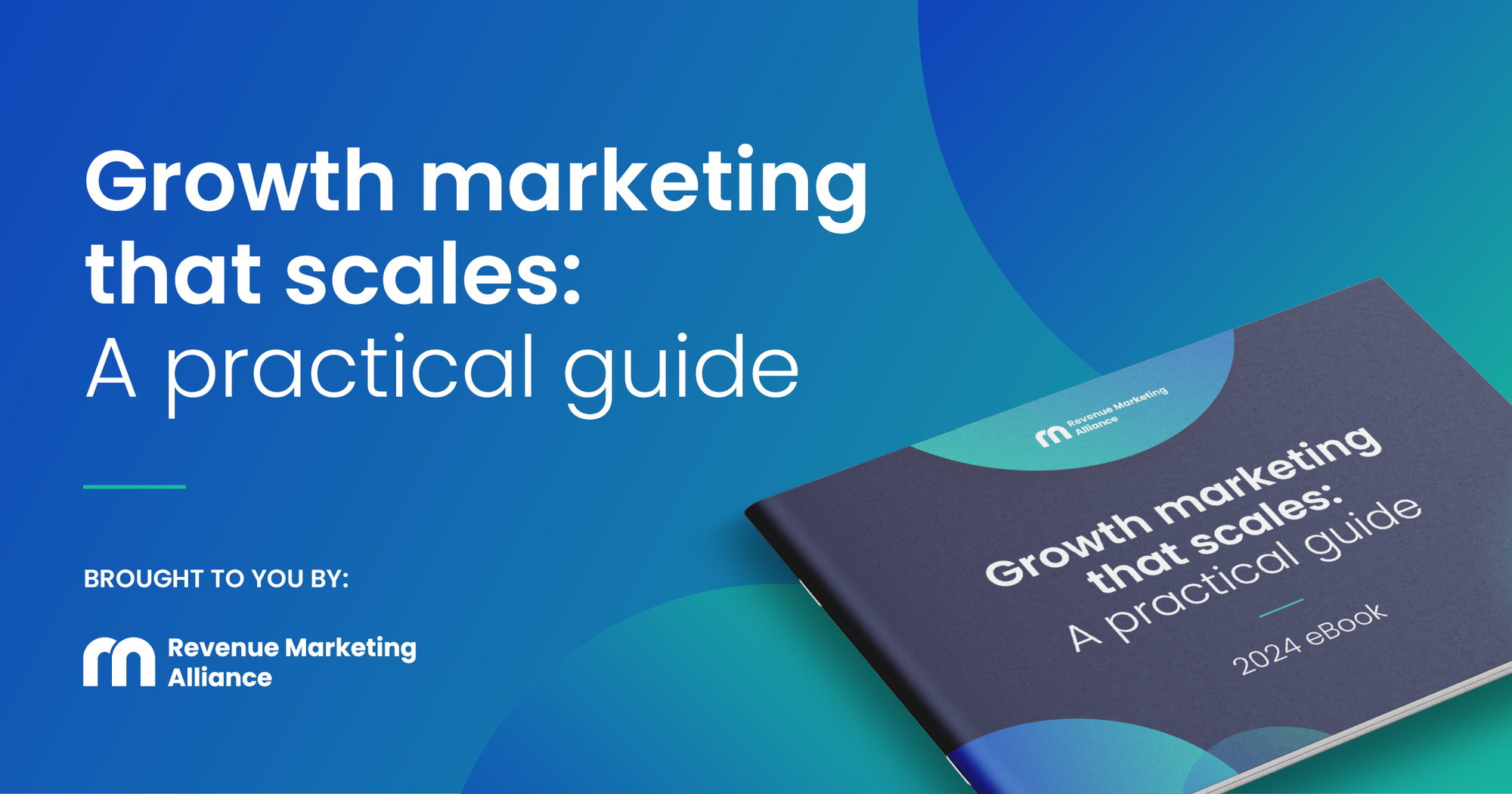Scaling demand generation in today's complex economic and regulatory environment is intricate and essential. The key lies in crafting strategies that resonate with our target audience and seamlessly align with evolving market dynamics and privacy norms.
I'm Carol Howley, CMO at Exclaimer, and my experience across various high-growth technology companies has honed my expertise in adapting marketing frameworks to meet and overcome these challenges.
In this article, I’ll share insights and strategies that help bridge the gap between traditional marketing practices and the demands of today, ensuring that our marketing efforts are both effective and compliant.
Prefer to listen? Check out Carol’s appearance on the Let’s Talk Revenue Marketing podcast 👇
Navigating demand generation in a challenging economic climate
The global economy is facing numerous challenges, from potential recessions to widespread layoffs and budget cuts. These conditions aren’t just hypothetical; they're having tangible impacts on strategies and operational capacities across various industries, including the tech sector.
Observing software buying trends over the past year, there have been notable shifts. Despite economic hardships, we've seen real "green shoots" in SaaS software purchasing, signaling underlying growth.
Reflecting on my own experiences as a former salesperson turned demand generation marketer, I've seen significant evolution in our field. Years ago, demand gen was synonymous with lead generation, often driven by countless gated campaigns.
I admit that I’ve run many such campaigns myself, and I recognize that these practices have influenced how demand generation has evolved and how consumer attitudes toward brands have changed.
As we look at these shifts and the broader economic context, it's clear that navigating demand generation now requires a clear understanding of market dynamics and consumer behavior. It's a challenging yet fascinating time to be in this space, trying to drive growth amidst such complexities.
Adapting demand generation strategies in the face of evolving market conditions
When scaling demand generation amid macroeconomic pressures and diminishing insights into prospect behaviors, it's important to have a coherent strategy.
Marketers today face the significant challenge of driving business growth beyond traditional campaigns and branding efforts. We must leverage all business aspects to stand out in the marketplace, especially as third-party cookie data phases out.
This shift represents a profound disruption in digital advertising and broader marketing practices. We’re compelled to rethink our strategies for planning, measuring, and engaging with our audiences.
Historically, marketing was heavily reliant on easily measurable and attributable channels such as paid advertising and content syndication. However, these methods are increasingly pushing buyers away as they now conduct up to 70% of their research and decision-making independently before engaging with sales content.
At Exclaimer, we’re observing a swing back toward investing in a strong brand and quality, personalized content. This approach aligns with the evolving buyer journey, where people are moving away from traditional interactions and engaging in what's termed "dark social" or modern word-of-mouth within their ecosystems.

Therefore, understanding and integrating into these communities and networks where decisions are made becomes crucial.
Our strategy involves producing engaging and valuable content that resonates deeply with our audience, providing compelling narratives that give people a reason to engage. We also incorporate AI tools to enhance our content creation, ensuring it maintains a human touch that stands out.
We leverage every communication channel to consistently promote our brand and messaging across all touchpoints.
To drive demand generation at scale, we need to immerse ourselves in the spaces where our potential customers are making decisions. This means going beyond simply creating awareness and establishing a strong brand presence. We need to strategically integrate ourselves into the ecosystems that influence our buyers' choices.
Dark social’s impact on marketing
Dark social refers to the parts of the customer journey that aren’t visible or trackable by standard marketing analytics. It encompasses all those interactions that occur off the traditional digital radar – actions that don't leave a digital footprint in a way that marketers can easily track.
For example, when individuals research products, they might disable cookies, use private browsing modes, or share links through personal messages on platforms like LinkedIn, WhatsApp, or Slack. These actions make their behavior invisible to traditional tracking methods.
Discussions about your brand or products often happen in informal, untrackable settings, like social media chats or at in-person gatherings like parties and networking events. Even though these interactions are fundamental in shaping buying decisions, they're not captured by typical web analytics or cookie-based tracking systems.
To navigate this “dark” aspect of social interactions, marketers can utilize social media monitoring tools that help detect untracked link sharing or discussions around key brand keywords.

Monitoring tools provide some visibility into how and where your brand is being discussed in more obscured environments, offering insights that can guide strategic decisions.
Dark social represents a significant portion of the buyer's journey that’s shifting increasingly out of marketers' direct control. Understanding and adapting to this reality requires you to think beyond conventional tracking and attribution models, embracing more holistic approaches to gauge brand influence and customer decision-making processes.
Laying the foundations for effective content marketing
When considering the foundations of effective content marketing, it’s essential to start with SEO.
In our portfolio of companies, over 90% are investing in SEO with established, mature programs. It's a cornerstone strategy that continues to evolve, especially with the potential impact of AI on SEO practices in the near future.

We also emphasize the importance of networking and partnerships. For instance, collaborations with platforms like Drift and Six Sense have proven beneficial. These partnerships enhance our visibility when our own SEO efforts don't reach the top of search results. Support like this enables us to amplify our collective online presence.
Creating high-quality content is fundamental. This includes diverse formats like videos, which are becoming increasingly important due to changes in how search engines and users interact with content. The goal is to produce content that’s genuinely interesting and provides value, moving away from traditional clickbait tactics that users have grown wary of.
In addition to SEO and content creation, paid digital advertising remains a significant element. Email marketing, virtual events, and in-person events are also standard practices that continue to be vital for engaging with audiences effectively.
Looking ahead, we're exploring various channels and strategies that may provide a competitive edge. While common content types like blog posts, white papers, and eBooks are still effective, they’re becoming saturated. It’s important to also consider other formats, such as interactive content like ROI calculators and video trials, which help users make quick decisions by providing them with straightforward, relevant information.
Lastly, engaging in niche areas, like specialized podcasts or leveraging review sites and community platforms, can offer unique opportunities for smaller companies to stand out. These channels allow for deeper connection and engagement, aligning with our overarching goal of not just reaching our audience but resonating with them meaningfully.
Navigating paid digital marketing in an evolving attribution landscape
Decreasing budgets and evolving privacy norms are forcing us to rethink our approach to paid digital marketing, particularly when it comes to attribution. As the use of cookies for tracking and attributing customer actions becomes less viable, we need to adapt.
Leveraging data and customer insights allows us to create targeted campaigns that resonate with our audience while respecting their privacy. The focus should be on understanding our customers on a deeper level and delivering value in a way that builds trust and fosters long-term relationships, rather than relying on invasive tracking methods.
With the anticipated challenges in attributing conversions directly to paid campaigns, it's essential to focus on understanding customer intent and behaviors through other means.
Tools that capture intent data, like those monitoring activities on review sites or search behaviors, can provide valuable insights. This data allows us to target individuals who are actively in the market for our products, enabling a more concentrated and effective use of our marketing budget.
Creating a tailored marketing strategy, which we term "ABX" or account-based experience, helps us navigate these complexities. Despite being a high-velocity company with a low average selling price, it's vital to address the entire decision-making process, which often involves multiple stakeholders and approvals, even for seemingly straightforward purchases.
Our approach involves wrapping around potential customers with consistent, relevant, and engaging messages, focusing on those who are demonstrably in the market. This targeted strategy not only optimizes our budget by concentrating on the most likely prospects but also addresses the various stages of their buying journey, from raising awareness to facilitating the final purchase decision.

Leveraging intent data and creating an account-based experience tailored to our unique business model and customer base enables us to maximize the effectiveness of our paid campaigns and ensure that every marketing dollar spent contributes to tangible business outcomes.
Optimizing conversions in a multi-channel marketing environment
Optimizing conversions is a multifaceted challenge that requires a cohesive strategy across all channels and a deep understanding of what a conversion means for your business. Our approach at Exclaimer focuses on harnessing every available touchpoint to enhance conversion rates, particularly through onsite interactions and the strategic use of email signatures.
The use of email signatures in our marketing campaigns exemplifies how every communication, even those that might seem routine, can be leveraged for marketing purposes.
For instance, our sales teams continuously engage with prospects, and our customer success teams interact with existing customers. We can transform standard emails into powerful marketing tools by incorporating strategic messages such as calls to action for NPS surveys or promoting webinars through these email signatures.
Additionally, aligning marketing strategies with our sales team is imperative. Often in the excitement of rolling out new campaigns, the connection with the sales team might be overlooked. Ensuring they’re fully briefed and prepared for any marketing initiative is essential for maintaining a consistent message and maximizing the impact of each campaign.
Our strategy also emphasizes the importance of clear and measurable objectives. This involves scrutinizing our key performance indicators (KPIs) and objectives to ensure they’re not only measurable but also directly tied to tangible business outcomes.
Continuous testing, feedback, and iteration on elements like landing pages and other customer-facing interfaces are vital to staying adaptive and responsive to market needs.
Nurturing every lead as if it's the only one we have is a principle that guides our interactions. This philosophy is particularly significant in ensuring that even potential customers who might initially purchase a smaller portion of our offerings are treated with the utmost importance and care. This approach fosters long-term relationships and enhances the customer experience, reflecting positively on our brand.
Ultimately, ensuring a seamless and personalized journey for every prospect and customer across all touchpoints – from marketing to sales to customer success – is essential. Optimizing every channel and conversation means maximizing conversions and ensuring our marketing efforts are as effective and efficient as possible.
Adapting marketing strategies for a challenging future
It’s evident that the traditional playbooks no longer suffice in creating successful strategies. Norms are dramatically shifting as a result of privacy concerns and buyer behavior changes, leading to a necessary evolution in our approach.
One critical aspect acknowledges that the straightforward lead-generation tactics of the past don’t deliver the same ROI today. Instead, our strategies must focus on creating real customer value, blending direct demand generation with long-term brand building.
The new playbook should center on brand authenticity, personal connections, and a customer-centric experience. Understanding the intricacies of the buyer journey is key, as is developing a smart, dynamic strategy that respects the buyer's privacy and intelligence.
In terms of content and conversions, we must focus on producing valuable, engaging content that feeds into our SEO efforts and attracts the right traffic. From there, judiciously using paid media to amplify well-performing assets and focusing on partnerships with third-party sites can enhance our profile and reach.
Meanwhile, optimizing every digital touchpoint – especially our website – is key to capturing and nurturing leads effectively.
Looking ahead, the ability to be agile and test different approaches will be key. You need to be ready to pivot and adapt, strategically using gated and ungated content to balance reach with engagement.
Ultimately, the success of our efforts will depend on how well we can integrate these strategies to not just cope with but thrive amidst these challenges.




 Follow us on LinkedIn
Follow us on LinkedIn



